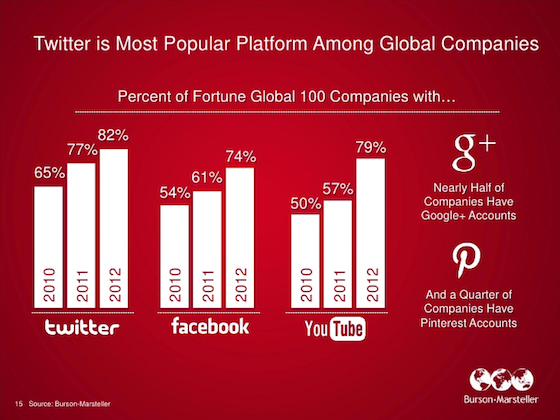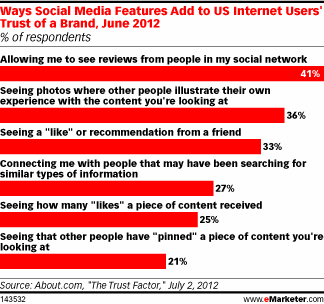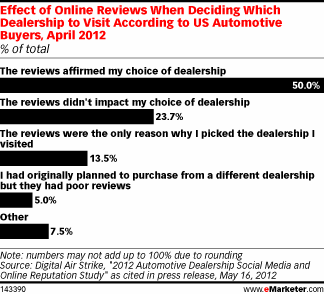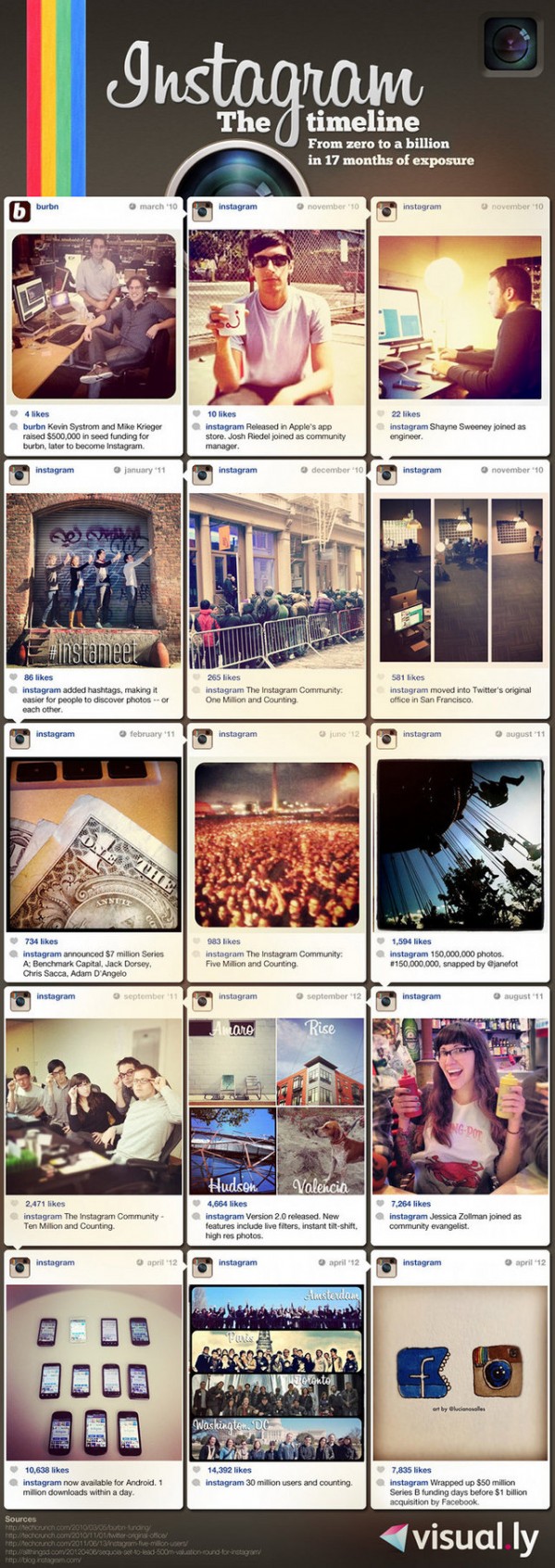Best selling author, world renowned speaker, one of the world’s most popular bloggers, entrepreneur and agent of change, Seth Godin talks about the idea that we must be willing to fail in order to succeed.
Reviews Are Key To Build Consumer Trust
Gaining consumer trust is an important issue for marketers seeking to ensure that they’re not scaring prospective customers away. In fact, a March to June survey of US adults conducted by About.com found that 84% of respondents felt that brands needed to prove themselves trustworthy before they would interact with them or other information sources. Moreover, the study found that there were 10 primary trust “elements,” or cues, that brands must establish in order to engender trust, including accuracy, expertise and transparency.
In a social media context, customers wanted to see that brands had a significant number of positive reviews, and that they didn’t go out of their way to hide the negative ones. The survey found that 41% of respondents said the ability to see reviews on social networks added to their feeling of trust in a brand. Reviews played a bigger role in cultivating trust than seeing that friends had “liked” or recommended a brand, or that the brand had accumulated a large tally of “likes.”
Video was found to improve trust the most when it served as a complement to other types of content. This ties back in to consumers’ hunger for useful information. Brands can build trust with potential customers by demonstrating expertise through quality owned content that is also devoid of a hard sales message.
Consumers Trust Online Reviews As Much As Personal Recommendations
The recent (2012) Search Engine Land’s Local Consumer Review Survey shows that since 2010, consumers are more likely to use the Internet to find local businesses, and they are doing it more often. They are also just as likely to turn to the internet, and trust online reviews as they are to ask for personal recommendations about local businesses.
- 85% of consumers surveyed have used the internet to find a local business in the past 12 months. This number is up from 79% in 2010.
- The majority of consumers surveyed use online reviews to make spending decisions. 27% of consumers are regularly reading online reviews, while another 49% are occasional readers.
- 65% of consumers (up from 58% in 2010) are reading between 2-10 reviews when researching local businesses.
- 72% of consumers trust online reviews as they do to personal recommendations.
- 58% of consumers trust a business which has positive online reviews (up from 55% in 2010)
- 52% of consumers are more likely to use a local business if they have positive reviews
- 28% of consumers cite location &/or price as main decision making factor (down from. 38% in 2010)
If you own a business, the statistics are clear, you need a strong online presence, you also need to monitor reviews and be proactive in following up with reviewers in a positive and constructive manner.
Reviews, even negative have always been opportunities to learn, to improve and create fans, do not ignore them, acknowledge reviewers, make things right if you can, pledge to improve, be transparent and truthful
Car Dealership Reviews Affect Purchase Decision
Almost seven in 10 consumers said dealership reviews affected their purchase decision
Just like consumers in almost every other sector of ecommerce, car shoppers are doing their research online before heading out to make a purchase. According to an April 2012 poll by Digital Air Strike of US consumers who had purchased a car in the last six months, review sites were a widely used tool by car buyers during the research phase of their purchase process. In fact, 69% of consumers said review sites had an impact on the dealership they visited.
Half of respondents said reading reviews of dealerships had affirmed their choice of where to make a purchase, while about one-quarter said the reviews had no effect on them. But online feedback from other customers held an outsized influence on a small minority of car shoppers—14% said reviews were the sole reason they had decided to visit a dealership. And 5% decided to change the dealership they bought from after reading negative reviews online.
And when it came to actually buying, almost seven in 10 shoppers said reviews had aided them in their purchase decision. About four in 10 said the reviews helped them in a general sense, while three in 10 had decided to purchase from a particular dealer based on online feedback from other customers. Moreover, if a dealership had been completely absent from review sites, one in 10 respondents would have been less likely to purchase from them.
New Social Media Stats Facebook and Instagram
Facebook and Instagram (now owned by Facebook) just published new statistics
Facebook revealed in its first earning report that it has 955 million active users, 552 million of which are using Facebook daily. 543 million of them are using Facebook from mobile devices, an increase of 29% and 32%, respectively, year-over-year. Facebook “Growth Team”, yes, Facebook has a squad whose sole purpose is to grow the user base, announced that they are on track to reach the 1B users mark by the end of the year
Instagram, has hit the 80 million user milestone and about 4 billion shared photos.
Social Media Marketers Must Provide Disclosure
Advertisers who make claims about their products on social media sites like Twitter, Facebook and Pinterest need to be mindful of the fine print they use, or forget to use, in their postings and provide disclosure.
Last week, the National Advertising Division, an investigative unit of the Advertising Self-Regulatory Council, reviewed photographs that Nutrisystem had “pinned” on Pinterest boards and determined that the photos were testimonials requiring disclosures. The photographs in question showed people who said they had lost weight by using Nutrisystem, but there was no disclosure that the people had been paid or that the results of their weight loss were not typical. Instead, the photos simply said, for example, “Christine B. lost 46 lbs on Nutrisystem.”
The self-regul atory council conducts independent reviews of marketing and advertising on all platforms, including social media. The group often responds to complaints brought by competing marketers who accuse others of violating advertising guidelines, like making unsubstantiated claims. Following a review, marketers often comply with requests to modify or settle the claim. If they refuse, the claim can be sent to the Federal Trade Commission for further review.
atory council conducts independent reviews of marketing and advertising on all platforms, including social media. The group often responds to complaints brought by competing marketers who accuse others of violating advertising guidelines, like making unsubstantiated claims. Following a review, marketers often comply with requests to modify or settle the claim. If they refuse, the claim can be sent to the Federal Trade Commission for further review.
Andrea Levine, the director of the National Advertising Division, said the organization tends to monitor advertising in categories like health and nutrition, dietary supplements and cosmetics closely. “Those are categories where companies are not watching each other as closely and bringing their own challenges,” Ms. Levine said.
In the Nutrisystem case, the company immediately agreed to add disclosure statements to its photographs, Ms. Levine said. “As long as their stories are truthful and as long as the advertiser discloses what is the normal weight loss range, which is 1 to 2 pounds a week, that lets the consumers put the success story in context,” Ms. Levine said.
Advertising on Twitter and Facebook is also monitored closely by the investigative units in the Advertising Self-Regulatory Council. In November 2011, for example, 1-800 Contacts challenged claims made on Facebook by a competitor, Coastal Contacts.
Coastal Contacts encouraged Facebook users to “like” its page and in doing so, promised them a free pair of glasses. It also promised discounts of 70 percent on contact lenses. The rival, 1-800 Contacts, said that Coastal Contacts did not disclose the shipping and handling fees associated with the offer for free glasses and that not all styles of glasses or lenses were available in the offer.
In addition, the company contended that users who “liked” the Coastal Contacts page in order to get the free glasses were inadvertently endorsing the company.
The National Advertising Division ruled that all claims for free merchandise must clearly disclose any hidden fees and conditions at the outset of the offer, including increasing the font size of the message that “conditions apply.” Facebook likes can be interpreted as “conveying a message of general social endorsement,” the ruling said.
“If what you are offering them in exchange for likes is not real, then those likes were obtained through deceptive advertising,” Ms. Levine said of the ruling.
One of the first social media cases taken up by a related organization, the Electronic Retailing Self-Regulation Program, involved Twitter. In July 2010, the program recommended that Liquid HCG Diet discontinue using testimonials that it made on Twitter — such as, “Becky and husband lost 14 lbs in 2 days!” — and claims on Facebook that said “Lose around a pound a day” and “Lose 30 lbs in a month, it’s easy and quick!”
Twitter now offers advertisers options like promoted tweets that make it more clear to users which posts are advertisements and which are authentic content.
“It’s kind of a reminder to advertisers that even though the medium changes the rules stay the same,” Ms, Levine said.
Twitter: Brands Can Now Target Promoted Tweets
Twitter continues to expand the effectiveness of “promoted tweets” (also known as ads), and today they are announcing a pretty significant new feature for advertisers.
Brands can now target Twitter users by location with their promoted tweets. For instance, if a brand wants to promote a tweet concerning a promotion that’s only taking place in Los Angeles – they can promote the tweet to their users in the L.A. area, or California or however specific of a location they wish.
From the Twitter Advertising blog:
Today we’re introducing targeted Tweets, an enhancement that enables brands to reach specific audiences on Twitter without first sending a Tweet to all followers. Now global brands that have different launch dates for several countries can send tailored messages at different times, customized for the users in each country. Mobile app providers who only want to reach customers on one device can do so without also sending the message to desktop users.
Social Media In Fortune 100 Companies
The third annual Burson-Marsteller Global Social Media Check-Up analyzed the social media activity of Fortune Global 100 firms – which includes such luminaries as Ford, Sony, AT&T, Honda and Walmart – on Twitter, Facebook, YouTube, Google+ and Pinterest in February 2012. The survey discovered that 87 percent of these companies are active on at least one social media channel, with Twitter leading the way.
 Since 2011, the average number of followers for a corporate Twitter account has almost tripled, from 5,076 to 14,709.
Since 2011, the average number of followers for a corporate Twitter account has almost tripled, from 5,076 to 14,709.
Perhaps surprisingly, YouTube finished second in the poll, with 79 percent of Fortune Global 100 corporates now using a branded YouTube channel, compared to just 57 percent in 2010.
Facebook placed third, with 74 percent of companies having an active Facebook Page. 93 percent of corporate Facebook Pages are updated at least weekly, and the average number of Likes per Page has increased by a heady 275 percent since 2010 to 156,646.
A little under half (48 percent) of firms are now using Google+. A quarter (25 percent) of these companies have Pinterest accounts.
Overall, Fortune Global 100 organizations have an average of 10.1 Twitter accounts, 10.4 Facebook Pages, 8.1 YouTube channels, 2.6 Google+ pages and 2.0 Pinterest accounts.
Instagram More Effective Marketing Tool Than Facebook?
If your brand’s social media strategy includes only Twitter and Facebook, you’re falling behind. Newer sites, such as Pinterest and Instagram, are growing rapidly and consumers are pushing the accelerator.
Instagram, for example, has grown from 5 million users to more than 30 million since its launch in October 2010. More than 1 billion photos are uploaded daily on the site. The mobile-centric, photo sharing platform has generated so much interest, Facebook dropped $1 billion for its acquisition in April.
What’s the appeal? According to Brian Zuercher, founder of social media photo aggregation company VenueSeen, people are visual, so consumers are naturally gravitating toward the image-based platform. Simply put, he says, Instagram provides a way for a brand to share its story through a series of photos, and for customers to directly connect with a brand.
“Text is simply not engaging, and that’s why Facebook went to Timeline, to add more imagery. A photo has four times as much influence as a comment because it’s visual; it sticks in people’s minds,” he said. “Brands are using this to tell their real story through photographs in which consumers are the curators.”
Instagram, he adds, has hit a critical mass of users. Sixty-percent of restaurant photos uploaded to the site are of food or drink, and restaurants are increasingly using those images as part of their digital marketing strategies.





